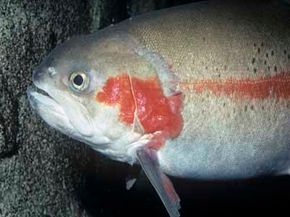As if overfishing, pollution and habitat-destruction haven't threatened the global fish population enough, virus strains creeping their way around the world are slaying even more saltwater and freshwater species. One virus that came to the United States by way of Eurasia in the 1950s is called whirling disease. Whirling disease is a parasitic infection that affects young trout and salmon. The parasite Myxobolus cerebralis first enters the fish's head and spinal cartilage, where it begins to multiply [source: Trout Unlimited]. As it reproduces, the parasite causes pressure around the fish's brain tissue to increase. Due to that added pressure, infected trout and salmon swim erratically in a whirling pattern [source: Trout Unlimited]. If the fish manages to survive the infection, it will suffer skeletal deformities.
Whirling disease is an example of an aquatic nuisance species (ANS), or a non-native organism that attacks native species and ecology. Maritime travel, human introduction of non-native species and reproduction all contribute to the growing problem of ANS. When it comes to fishing, you can think of the spread of ANS in the same way that you track mud from your shoes into a house. If you trudge around carelessly with soiled shoes, you'll leave a trail everywhere you go. The same goes for fishing gear and boats. You can track bacteria and infected species into untainted waterways, introducing new pathogens and possibly threatening the health of the aquatic ecosystem.
Advertisement
One way that fishermen may be "tracking" pathogens from lake to lake (or wherever they're fishing) is through fishing bait. Many piscine viruses target only certain species. However, other unaffected fish may harbor diseases and serve as vectors, or carriers. You can compare this to plague pathology. Rats and other vermin are often the vectors that eventually transmit the bacteria to humans. Similarly, trout or salmon that eat infected fishing bait -- whether alive or dead -- can contract whirling disease. The parasite's spores can also spread through infected waterways.
Since 2003, wildlife authorities in North America have pointed the finger at fishing bait as the culprit for the proliferation of another fish disease. But unlike whirling disease that only involves the Salmonidae family, this virus is a far more indiscriminate killer.
Advertisement



